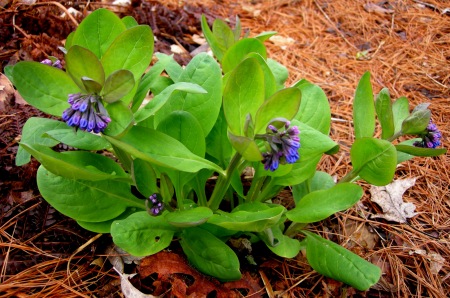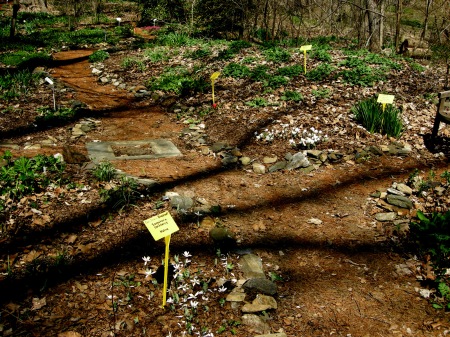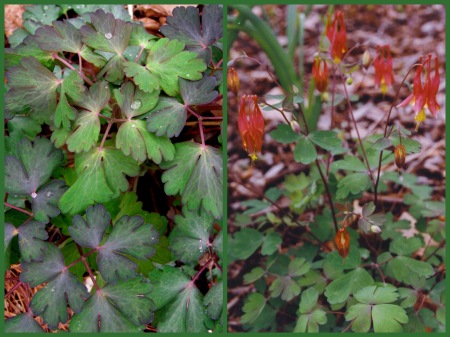Carolyn’s Shade Gardens is a retail nursery located in Bryn Mawr, PA, specializing in showy, colorful, and unusual plants for shade. The only plants that we ship are snowdrops and miniature hostas. For catalogues and announcements of events, please send your full name, location, and phone number (for back up use only) to carolyn@carolynsshadegardens.com. Click here to get to the home page of our website for catalogues and information about our nursery and to subscribe to our blog.
 Part of the Idea Garden at Longwood Gardens
Part of the Idea Garden at Longwood Gardens
I recently visited Longwood Gardens in Kennett Square, Pennsylvania. I have no hesitancy in saying that Longwood is one of the premier gardens in the world and should be on everyone’s life list. However, there is so much there that it is difficult to post about it. Also, “familiarity breeds contempt.” I hold two Certificates in Ornamental Horticulture from Longwood and have taken a total of 18 courses to earn them. Each course involved a minimum of 8 visits to the gardens so you can see that I have spent a lot of time there. If you are local, these courses are the absolute best plant education available.
 Italian Water Garden, viewed while resting in the shade.
Italian Water Garden, viewed while resting in the shade.
Because I have spent so much time at Longwood, I didn’t photograph the usual sights or even visit the fabulous four acre indoor conservatory (with one exception mentioned below). As a shade gardener I headed straight for Peirce’s Woods, which is seven acres devoted to shady plants native to the eastern U.S. deciduous forest. I hoped to augment my library of photographs and get some ideas of plants to sell at the nursery and add to my own gardens. I wasn’t disappointed.
 The straight species of smooth hydrangea, H. arborescens, lined the very shady paths by the lake. I think it is more appropriate to a woodland garden than the cultivated forms like ‘Annabelle’.
The straight species of smooth hydrangea, H. arborescens, lined the very shady paths by the lake. I think it is more appropriate to a woodland garden than the cultivated forms like ‘Annabelle’.
 Smooth hydrangea has a lovely flower whose size is in keeping with other native woodland plants.
Smooth hydrangea has a lovely flower whose size is in keeping with other native woodland plants.
While walking through Peirce’s Woods, I returned to the thoughts I have been having lately about groundcovers. This time of year, with the weeds running rampant, my customers are more interested in groundcovers. But it is clear from their questions that they mean plants that form runners to creep and cover the ground. The classic examples are vinca, ivy, and pachysandra. However, my definition of groundcover is much broader than this and includes any plant massed to effectively choke out weeds.
 Native maidenhair fern, Adiantum pedatum
Native maidenhair fern, Adiantum pedatum
When you look at the masses of native maidenhair fern above, you are probably thinking that’s all very nice that Longwood uses masses of these fairly pricey, non-creeping plants as groundcover, but I could never afford that quantity of plants. However, think of the alternative: weeds and the hours if not days it takes to remove them, not to mention how their presence detracts from the look of your garden as well as your satisfaction with it. Your time is valuable, and you wouldn’t be reading my blog if the look of your garden wasn’t important to you.
 Native semi-evergreen coralbells, Heuchera villosa, often sold as the cultivar ‘Autumn Bride’, has gorgeous white flowers in the fall.
Native semi-evergreen coralbells, Heuchera villosa, often sold as the cultivar ‘Autumn Bride’, has gorgeous white flowers in the fall.
Yes, you can use mulch to keep down the weeds. However, commercial shredded hardwood mulch is not attractive, is generally not produced sustainably, and requires a significant time investment to apply it. Most importantly, it requires a monetary outlay every year because it must be re-applied every spring. Perennial plants are initially more expensive to buy and plant but once they are there, you never have to do anything again. It is kind of like buying a compact fluorescent light bulb versus the bulbs we grew up with.
Here are some more plants that Longwood uses in masses to make effective groundcovers:
 Mexican feather grass, Nassella tenuissima
Mexican feather grass, Nassella tenuissima
 Native evergreen Christmas fern, Polystichum acrostichoides
Native evergreen Christmas fern, Polystichum acrostichoides
 Native semi-evergreen coralbells, Heuchera villosa purple form.
Native semi-evergreen coralbells, Heuchera villosa purple form.
 Shredded umbrella-plant, Syneilesis aconitifolia: I can only dream of achieving this in my garden, and, yes, it is very expensive.
Shredded umbrella-plant, Syneilesis aconitifolia: I can only dream of achieving this in my garden, and, yes, it is very expensive.
 Native hay-scented fern, Dennstaedtia punctiloba, creeps to fill in large areas.
Native hay-scented fern, Dennstaedtia punctiloba, creeps to fill in large areas.
 This bellflower, Campanula takesimana, was growing and apparently self-sowing in dense shade on the hillside near the Chimes Tower.
This bellflower, Campanula takesimana, was growing and apparently self-sowing in dense shade on the hillside near the Chimes Tower.
 Fall-blooming yellow waxbells, Kirengoshoma palmata, is more like a shrub than a perennial but it dies to the ground ever year.
Fall-blooming yellow waxbells, Kirengoshoma palmata, is more like a shrub than a perennial but it dies to the ground ever year.
 Native coralbells, Heuchera villosa ‘Caramel’, is my favorite heuchera and retains its lovely color 365 days a year.
Native coralbells, Heuchera villosa ‘Caramel’, is my favorite heuchera and retains its lovely color 365 days a year.
 Giant butterbur, Petasites japonicus, grows in dense shade and covers a lot of ground.
Giant butterbur, Petasites japonicus, grows in dense shade and covers a lot of ground.
 Lavender mist meadow-rue, Thalictrum rochebrunianum
Lavender mist meadow-rue, Thalictrum rochebrunianum
 Native sensitive fern, Onoclea sensibilis, does creep.
Native sensitive fern, Onoclea sensibilis, does creep.
Shrubs can be used as groundcover also, two examples from Longwood:
 The straight species of oakleaf hydrangea, H. quecifolia, gets quite large and spreading.
The straight species of oakleaf hydrangea, H. quecifolia, gets quite large and spreading.
 Native southern bush honeysuckle, Diervilla sessifolia, suckers to form a colony.
Native southern bush honeysuckle, Diervilla sessifolia, suckers to form a colony.
Lastly, I want to show you why I briefly visited the conservatories: groundcover for walls, the new fern wall at Longwood. It is worth a visit just to see it:
 This is a beautiful hallway containing individual restrooms, and the walls are totally covered in ferns.
This is a beautiful hallway containing individual restrooms, and the walls are totally covered in ferns.
 Some of the ferns are quite large, and all are healthy and beautiful.
Some of the ferns are quite large, and all are healthy and beautiful.
I hope I have convinced you to think outside the box and mass all kinds of unusual plants as groundcovers. You will have more time to enjoy a better looking garden and save money in the long run.
Carolyn
Nursery Happenings: This coming weekend we will have our final open hours at the nursery on Saturday, June 16, from 9 am to 2 pm, and Sunday, June 17, from 11 am to 1 pm. We close on June 17 until September. Customers on my email list will receive an email with details.
If you are within visiting distance and would like to receive catalogues and information about customer events, please send your full name and phone number to carolynsshadegardens@verizon.net. Subscribing to my blog does not sign you up to receive this information.
Facebook: Carolyn’s Shade Gardens has a Facebook page where I post single photos, garden tips, and other information that doesn’t fit into a blog post. You can look at my Facebook page here or click the Like button on my right sidebar here.
Notes: Every word that appears in orange on my blog is a link that you can click for more information. If you want to return to my blog’s homepage to access the sidebar information (catalogues, previous articles, etc.) or to subscribe to my blog, just click here.

































